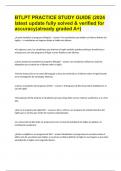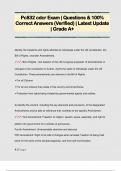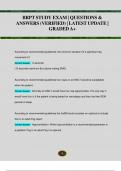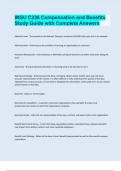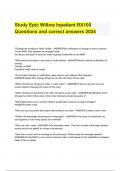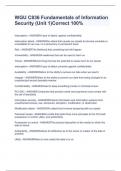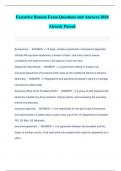FISDAP AIRWAY EXAM 3 VERSIONS (VERSION A,
B & C) LATEST 2024-2025 ACTUAL EXAM 150
QUESTIONS AND CORRECT DETAILED ANSWERS
(VERIFIED ANSWERS)
Practice questions for this set
Learn 1 /7 Study with Learn
Respiration refers to the exchange of gases in the alveoli, ventilation refers to
the movement of air into the lungs. Respiration is needed to provide O2 to
cells and remove waste products. Also regulates pH of blood.
Give this one a try later!
What structure is considered a
What is the difference between
2 landmark that divides the upper
respiration and ventilation?
airway from lower?
True or false: arteries bring
What factors can lead to hypoxia
3 oxygenated blood to 4
due to circulatory compromise?
organs/capillaries
Don't know?
,Terms in this set (104)
From the atmosphere, what Starts in atmosphere, then nose, nasopharyngeal
structures does air pass space/orophargyneal space (if mouth breather), then
through during ventilation? pharynx, larynx, trachea, bronchi, bronchioles, alveoli
What is the purpose of the To warm/humidify air as it passes through
nasal passages and
nasopharynx?
Respiration refers to the exchange of gases in the
What is the difference
alveoli, ventilation refers to the movement of air into the
between respiration and
lungs. Respiration is needed to provide O2 to cells and
ventilation?
remove waste products. Also regulates pH of blood.
What are the structures of nose, mouth, tongue, jaw, pharynx and larynx
the upper airway?
What structure is The larynx, anything above is upper. The larynx and
considered a landmark that below are lower.
divides the upper airway
from lower?
larynx (includes adam's apple/thyroid cartilage,
What are the structures of
cricothyroid membrane, cricoid cartilage), trachea,
the lower airways?
bronchi, bronchioles, alveoli
From superior to inferior. Thyroid cartilage, cricothyroid
Describe the anatomy of membrane, and cricoid membrane. The thyroid cartilage
the larynx. and cricoid cartilage are anterior to the larynx, and the
cricothyroid membrane is posterior to both structures.
True or false: the lungs are False, right lungs has 3 lobes, left lung only has 2 lobes.
completely equal in the Together they have 5 total. Also, the right bronchi is
midsaggital plane. inferior to the left bronchi.
What are the structures of bronchioles, and alveoli
the lungs in order of
ventilation?
, False: the lungs are hollow organs and contain no
True or false: the lungs use muscles. When the diaphragm contracts it expands the
muscles found in the lateral thoracic cavity. The pleural space has a negative
lobes to expand and pressure and the lungs expand. This results in a slightly
contract? negative pressure (compared to the atmosphere) and air
rushes in.
True, when the lungs expand, they are creating a vacuum
True or false: Air rushes into because they are expanding the volume of the container.
the lungs because of This increase in volume causes influx of air into the
negative pressure. container until the pressure is equalized with the
atmosphere.
True or false: The parietal False: the visceral pleura lines the lungs, the parietal
pleura lines the lungs and pleura lines the body cavity and the pleural space is the
the visceral pleura lines the space in between both where body fluid allows for both
lungs. The space between is to smoothly glide.
called the anterior pleura.
What muscles are involved The diaphragm, cervical muscles (neck), intercostals,
in inhalation? abdominal muscles, and pectoral muscles.
What muscles are involved none, expiration (if done passively) is achieved by the
in expiration? relaxation of the diaphragm.
The CSF in the brain has chemoreceptors sensitive to
CO2. When there is too much CO2. The pH changes.
These sensors feed back to the medulla oblongata,
which stimulates the phrenic nerve which innervates the
What is the primary driver
diaphragm. They cause an increase in activity of the
of respiration? (Why would
diaphragm. This increases the RR which causes us to
we increase/decrease RR?)
increase tidal volume. This means more CO2 is exhaled.
And brings our pH back to normal.
We also have the less sensitive hypoxic drive
Backup system to control respiration. Chemoreceptors in
brain, aorta, and carotid arteries. But they are "satisfied"
What is hypoxic drive?
by a small amount of O2, which means it is not as
sensitive as pH control of CO2






